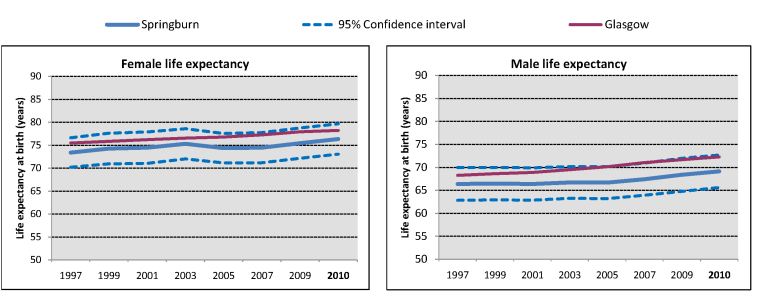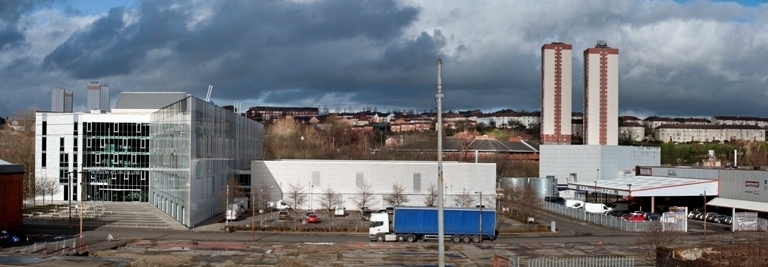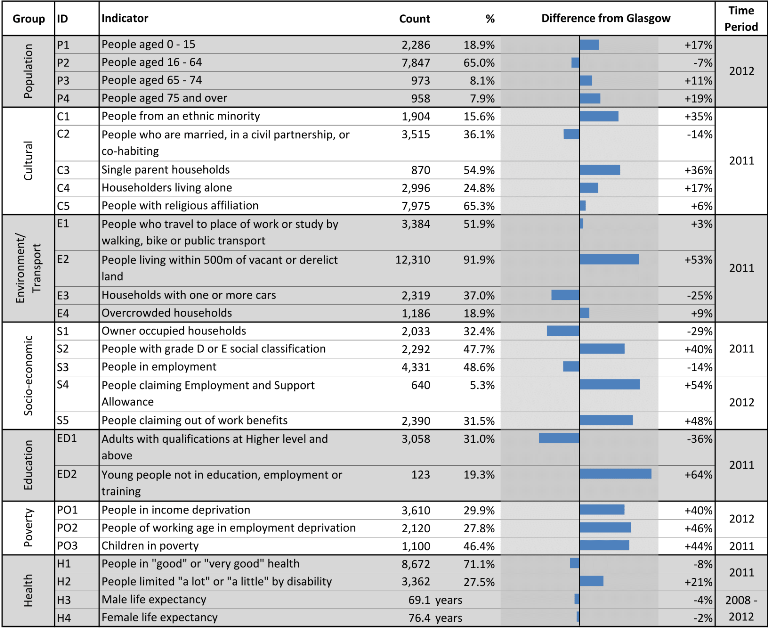Springburn
*Please note that this profile is based on data from the 2011 Census.*
A printer friendly version of this neighbourhood profile can be downloaded here.
Springburn is a neighbourhood in the north east of Glasgow with a population of 12,064.
Neighbourhood comparisons with Glasgow
Women in Springburn live, on average, seven years longer than men. Estimates of male and female life expectancy in Springburn are lower than the Glasgow average. The area has a high proportion of people claiming Employment and Support Allowance and of young people not in education, employment or training compared to the Glasgow average. There is also a high proportion of people living within 500m of vacant or derelict land, and single-parent households make up 55% of all households with dependent children.
Neighbourhood trends
 Life expectancy for both males and females has risen in recent years in Springburn but has remained below the Glasgow average. In the most recent period shown (2008-12), life expectancy was notably lower than the Scottish average, particularly for men.
Life expectancy for both males and females has risen in recent years in Springburn but has remained below the Glasgow average. In the most recent period shown (2008-12), life expectancy was notably lower than the Scottish average, particularly for men.
 The overall population of Springburn fell by approximately 11% between 1996 and 2012. Adults aged 16-44 make up a large proportion of the population. The percentage of the total neighbourhood population from a minority ethnic group increased from 3% in 2001 to 16% in 2011. The percentage of the neighbourhood’s population from an ethnic minority group was higher than the Glasgow average in 2011.
The overall population of Springburn fell by approximately 11% between 1996 and 2012. Adults aged 16-44 make up a large proportion of the population. The percentage of the total neighbourhood population from a minority ethnic group increased from 3% in 2001 to 16% in 2011. The percentage of the neighbourhood’s population from an ethnic minority group was higher than the Glasgow average in 2011.
Notes
A document giving detailed notes and definitions for the information presented in this profile can be downloaded here.
An Excel workbook containing the data used in all of the profiles can be downloaded here. This workbook also includes alternative output formats and further breakdowns of some of the variables.
1. Data sources: Scottish Index of Multiple Deprivation (SIMD) 2012, Census 2011, Census 2001, HMRC, NOMIS, National Records of Scotland (NRS) and Scottish Government.
2. Populations presented in the population trend chart and used to calculate life expectancy estimates are taken from NRS small area population estimates and are based on: the 2001 Census for the years 1996-2001; both the 2001 and 2011 Census for the years 2002-2010; and the 2011 Census for the years 2011-2012.
3. The Income deprivation and Employment deprivation indicators are derived from SIMD 2012, more information on this deprivation index can be found at: http://simd.scotland.gov.uk/publication-2012
4. Life expectancies are calculated based on population estimates and death registrations. 95% confidence intervals have been added on the graphs to give an indication of their accuracy. The x-axes of the life expectancy graphs give the mid-year for each life expectancy estimate, e.g. 2010 represents the life expectancy estimate for the period 2008-2012.
Glasgow City Council have also produced neighbourhood profiles based on data from the 2011 Census 2011 which can be accessed via this link.

